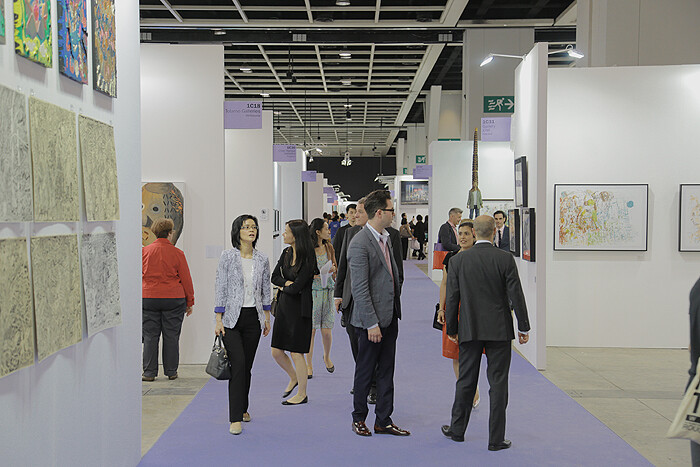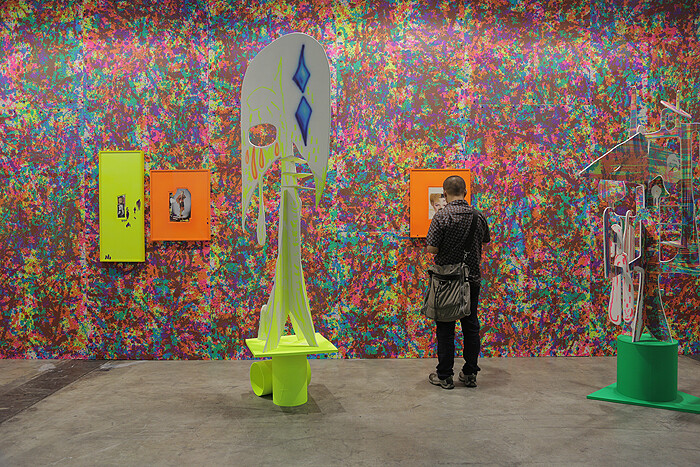It was a debut, a big one. But the private preview opening of Art Basel Hong Kong was threatened with a black rainstorm warning, which yielded nothing other than the solid banality of Hong Kong humidity. Inside, relief: the Art Basel HK fair feels like a nineteenth-century crystal palace, spacious, inclusive, airy, with the eternal sunshine of allure. The fair takes up two floors (first and third) in the exhibition center in Wan Chai, where all commercial fairs happen in Hong Kong.
I would be lying if I were to say that I could cover the entire fair in a thousand words, however one can point to the highlights of the fair’s four sections. The Galleries sector is made up of 170 galleries beyond the toddler stage. Art-star chasers are justly rewarded here, with A, B, missing our C and D, adding E and jumping to K, M, and finally W: Abramović, Basquiat, Emin, Kapoor, Koons, Murakami, Warhol, the alphabetic dramaturgy of the blue chips’ greatest hits. It was my feet, however, that took that greatest beating, on four-inch heels for five hours, I felt tall but small. Aaron Curry’s works presented by Michael Werner offered up a messianic moment, when a tribal “yay” in my brain conquered the sore toes and Achilles’ heel to fashion. Small splashes of neon colors set behind Curry’s signature abstract sculptures, pleasure dome shock brought about by eye-blinding hues, an imaginary plane of pre-linguistic pleasure. You won’t be able connect the work with a signification system, but you don’t want to anyway. And it is amazing to look at the fierce fight of color between Curry’s works and Liam Gillick’s Complete Bin Development (2013)—a large-sized installation that makes part of the Encounters section with Dublin’s Kerlin Gallery just opposite.
Spatial disorientation was more the theme of Indian artist Praneet Soi’s work in Mumbai’s Guild Art Gallery booth. Exploring pattern formalism and the psychological displacement of urban spaces—like the flashy Nokia Tower in Vilnius—the artist contemplates urbanity via fragmentation, twisting and dissolving architectural structure to meticulous patterns on canvas or paper, seducing human brains to suture them into something compatible with the precepts of linear perspective. In addition, the solo booth of Alexander May presented by Galerie Balice Hertling is one that should not be missed. Here the artist, who suffers from dyslexia, visualizes and expands upon this limitation with short, broken lines on orange-red surfaces.
Sauntering into the Insights section—the one harboring the Asian/Asia Pacific region galleries developing projects specially for the Hong Kong show presenting the artists from the same region—the mindset is more or less “looking at Asia” from Asia. However, some works risk falling into a simplified symbolic exchange or even encouragement of stereotypes of art in a certain region. One obvious example is the Gao Brothers (Zhen and Qiang), who bring us more Mao Zedong (are we surprised?). I respect that Chinese artists may wish to work through their PTSD, or shanghen (scar) culture, in response to the Cultural Revolution, but when even the CCP has shifted its modus operandi to totalitarian capitalism, maybe some new critique should be produced. There is another section called Discoveries, showing works by emerging artists. Weingrüll’s Benjamin Appel’s Keller und Küche (2013), an installation of a cooking island topped by concrete and surrounded by paintings, may remind some people of the “Judd or a piece of furniture” dilemma. It is an experiment in looking at furniture drawn from domestic settings, which possess basic shapes but a multitude spatial possibilities, and how a communal of space of livability may be constructed and deconstructed.
I did have great expectations about the gargantuan sculptures promised in Encounters (which included the aforementioned Gillick piece.) In this section, curated by Yuko Hasegawa, the Chief Curator of the Museum of Contemporary Art, Tokyo and the most recent Sharjah Biennial, big doesn’t always mean great. Madein company (a cultural “company” established by Long March artist Xu Zhen) created a church made of S & M suit material and thin silvery chains, a rather obvious stab juxtaposing the sacred and the sexual. Zhuang Hui and Dan’er took up the same motif of adopting simple symbols for their visual dialectic. Their 11 Degrees Incline (2008) is an adaptation of the sunken ruins of the old Summer Palace—a “patriotic education base” in China where the remains of wars are kept as a reminder of hatred, and hence a backdrop for many diplomatic affairs—made all black and glossy (read: sculptural) here. In my eyes, the attempt to (dis)place this strong patriotic symbol in an international fair is too much of an East-and-West soap opera. (Their otherwise nation-less sculptures, in which leftover carpenter shop materials are enlarged and scattered around the floor, are worth a second look.)
Of course, this is not to forget the parties and funky watering holes, among these the art bar of Adrian Wong, Wun Dun (“chaos” in Cantonese) in collaboration with the Absolut Art Bureau. Located in the basement of the Fringe Club—a former dairy storage built in the late-nineteenth century, the bar is lit up by the red haze of a neon sign of a Chinese gourd (hulu) and a copper coin, go figure. Two furry, Grimace-like robots played musical instruments for us—a clever avatar of local experimental hero Alok Leung, whose soft-porn music filled the room (and Christiaan Virant from FM3 may put on some North Korean commie funk in the coming nights). Fish tanks filled with weird creatures—centipede-eaters and flesh-colored frogs—were a nice after effect.
The greatest thing about Art Basel HK is that it tries to dissolve the tyranny of choice between global and local—though whose world is not ruptured by the “big optics” wormholes of telecommunication anyway? A lot of Asian art fairs stage this dualism in the form of an “Asian platter”—art with recognizable Asian cultural symbols along with some international art stars. Although more than half of the galleries at the fair come from Asia, Art Basel HK is not about secluded spheres of “Asian art.” It contributes, however, towards constructing a sphere of visibility—what artistic landscape is going to be made visible when we talk about Asia in an artistic context. Of course, the geopolitics of the globalized world is never far away, and the art Pantagruel is setting down its proverbial third foot in Hong Kong for a reason (geography, cachet, generous tax policy towards art purchases, etc., etc.), but at the same time, it is sophisticated enough not to reduce the whole multitude of art and culture to the monotonous operations of global capital. It is Art Basel, after all. A certain panache in these matters is to be expected.
The ArtHK fair had a tradition of happening (more or less) at the same time as the Funeral Fair, and the Art Basel HK fair debut does not benefit from an exception. The afterlife-crazy funeral fair is as weird and cool as it sounds, digital tombstones and corn-made urns abound, everything one might or might not need in the afterlife. Apart from the coffins covered with gold leaves (Hirst’s very own future sarcophagus?), it shares other unique traits with the art fair: no one has a monopoly on defining the concept of Asian art, any more than a funeral fair has any business educating us on the truths of death. You can still believe in your hell and heaven, hot or cold. The world, however, remains round and messy, or as Peter Sloterdijk once said, “All individuals are living in a specific bubble within a communicating foam.” 1








